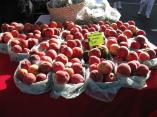One of the difficulties of trying to eat local food is that you can’t trust food labels, at least not in Canada. Last October, CBC’s Marketplace broadcast an enlightening program about the meaning of the ‘Product of Canada’ label, which you can watch again online, in which they revealed that this branding means that 51% of the production costs (not even the content) were spent in Canada. This is allowed thanks to legislation created in 1985, when 20% of Canadian food was imported; now we’re at the 40% stage, it is starting to sound downright silly, let alone outdated.
So in the example given, of Highliner frozen fish products branded ‘Product of Canada’, the fish may have been farmed in Vietnam, Indonesia or China and then shipped frozen to Canada for processing, becoming Canadian somewhere en route. When the program-makers went to Lunenburg, the published address for Highliner, they were told that no fishing boats had come in there for six or seven years.
All of which is problematic to consumers: they can’t make informed choices, because the information they’re using is flawed and misleading. They can’t vote with their wallets against poor labour practices, potentially unsafe food production practices, unsustainable fishing practices, or unsound ecological practices, and they can’t even support local producers because they cannot tell (from packaged goods anyway) which products are truly local.









0 Responses to The difficulty of eating local